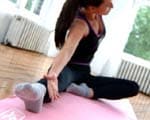Patients with osteoarthritis (OA) of the knee or hip who adhere to the recommended home exercises and physically active lifestyle experience improvement in pain and physical function.

Individuals with OA of the hip or knee experience pain, reduced muscle strength, decreased range of joint motion and joint instability. Often OA patients are referred to physical therapy in order to reduce impairments and improve overall physical function to meet demands of daily living.
To assess adherence to self-directed exercise (during and after prescribed physical therapy treatment period) on patient outcomes of pain, physical function, and self-perceived effect, researchers studied 150 patients with OA in The Netherlands. Three forms of adherence to agreed recommendations by his or her physical therapist, were measured - adherence to home exercises, home activities, and increased physical activity. Participants completed questionnaires to measure the adherence to home exercise (e.g. muscle strengthening exercises) and activity (e.g. walking or cycling). Assessment of adherence started at start of the study, and then took place again at intervals of 3, 15, and 60 months.
It was found that regular exercise and having a physically active lifestyle after discharge of physical therapy improved the long-term effectiveness of exercise therapy in patients with knee or hip OA. One hour per week more of physical activity at a moderate level resulted in an improvement in self-reported physical function. During the physical therapy treatment period, the patients' physical activity increased by one and a half hours of moderate or vigorous intensity physical activity per week. After the treatment period, physical activity declined by 30 minutes and one hour respectively at the 15- and 60-month follow-up.
Results show at the 3-month follow-up 58 percent of study subjects adhered to the recommended exercises and 54 percent to recommended activities. Adherence to exercise was significantly associated with a decrease in pain and improvements in self-reported physical function and physical performance. A higher level of moderate or vigorous intensity physical activity was significantly associated with a decrease in pain, physical function and physical performance, as well as a positive self-perceived effect.
This study shows that better adherence to home exercises and being more physically active improves the long-term effectiveness of exercise therapy in patients with OA of the hip and / or knee.
DoctorNDTV is the one stop site for all your health needs providing the most credible health information, health news and tips with expert advice on healthy living, diet plans, informative videos etc. You can get the most relevant and accurate info you need about health problems like diabetes, cancer, pregnancy, HIV and AIDS, weight loss and many other lifestyle diseases. We have a panel of over 350 experts who help us develop content by giving their valuable inputs and bringing to us the latest in the world of healthcare.












